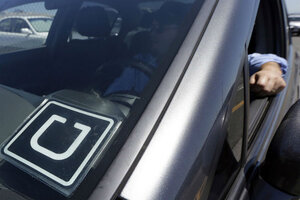Why Uber will invest $500 million to map the world
Uber plans to invest in its own precise mapping system as part of its effort to develop driverless cars.

An Uber driver sits in his car near the San Francisco International Airport on July 15, 2015.
Jeff Chiu/File/AP
Uber plans to map the world, freeing itself from reliance on Google Maps and paving the way for its own fleet of driverless cars.
Uber’s mapping vehicles hit American roads last year, were introduced in Mexico earlier this summer, and will eventually extend to the other 76 countries where the ride-hailing service operates, gathering precise data on pickup and drop-off locations and traffic patterns. Following an influx of $3.5 billion from Saudi Arabia’s sovereign wealth fund, Uber says it will invest $500 million in developing its in-house maps, the Financial Times reported.
“With autonomous vehicles, maps are going to be fundamental,” Brian McClendon, a vice president at Uber, told The Atlantic. “And the maps that are needed for autonomous vehicles are beyond anything that’s being created today by any third party.” An expert in geospatial data visualization, Mr. McClendon led Google Maps for more than a decade before jumping to Uber to lead its mapping projects last June.
Google, an early investor in Uber, is now one of its competitors in the race for autonomous vehicles. Google's driverless cars have travelled more than 1.7 million miles autonomously, relying on Google's approach to mapping roads. Its system gives a clear 3D picture of what empty roads look like, composed of millions of data points, which cars can subtract out to compare to what they're currently seeing, as Forbes reports.
But Google has hiked its fees to use Google Maps, making reliance on the company even less attractive for Uber.
Already, each company pursuing self-driving vehicle technology has its own approach. One British startup, FiveAI, challenges the need for detailed maps for autonomous vehicles altogether. FiveAI has secured $2.7 million in its bid to remove the need for “prior 3D mapping” of environments, as TechCrunch reported. Using, computer vision and AI/machine learning, self-driving cars can learn to understand and navigate even crowded urban environments based on just a simple map, according to the startup's officials.
But Uber is taking the cue from other companies well on their way to developing autonomous cars that are heavily committed to maps. In mid-July, Uber also launched a partnership with DigitalGlobe to gain access to the company’s high resolution satellite imagery. German automakers outbid Uber to purchase Nokia’s HERE Map business last summer.
Apple debuted its own maps in 2012, and has recently prioritized developing the software for its under-wraps autonomous car initiative, dubbed Project Titan. Meanwhile, Tesla is creating high-precision digital maps using data collected by its Model S drivers.
One advantage of Uber creating its own maps could be a chance to include precise details, like the location of a front door of an office building or a driveway, to help drivers identify exactly where passengers are waiting to be picked up. In developing countries where Google Maps tends to be less accurate and street signs aren’t ubiquitous, Uber drivers often have to call passengers to clarify their location, the Financial Times reports – an inconvenience Uber hopes to eliminate.
Uber, most recently valued by investors at $62.5 billion, is now Silicon Valley’s most highly valued private company. Saudi Arabia’s sovereign wealth fund’s recent investments top not only every investment in Uber, but every investment ever made in a start-up, setting Uber on firm financial footing to forge its own path in the autonomous car market.

